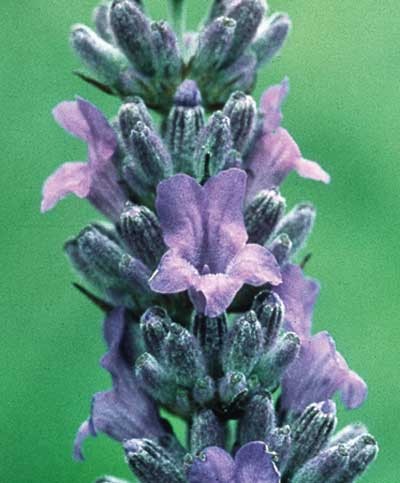English lavender
(Lavandula angustifolia angustifolia)

Description
Lavandula angustifolia, formerly L. officinalis, is a flowering plant in the family Lamiaceae, native to the Mediterranean (Spain, France, Italy, Croatia etc.). Its common names include lavender, true lavender or English lavender (though not native to England); also garden lavender, common lavender, and narrow-leaved lavender. It is a strongly aromatic shrub growing as high as 1 to 2 metres (3 ft 3 in to 6 ft 7 in) tall. The leaves are evergreen, 2–6 cm (1–2+1⁄2 in) long, and 4–6 mm (3⁄16–1⁄4 in) broad. The flowers are pinkish-purple (lavender-coloured), produced on spikes 2–8 cm (1–3 in) long at the top of slender, leafless stems 10–30 cm (4–12 in) long. The species name angustifolia is Latin for "narrow leaf". Previously, it was known as Lavandula officinalis, referring to its medicinal properties. English lavender is commonly grown as an ornamental plant. It is popular for its colourful flowers, its fragrance, and its ability to survive with low water consumption. It does not grow well in continuously damp soil and may benefit from increased drainage provided by inorganic mulches such as gravel. It does best in Mediterranean climates similar to its native habitat, characterised by wet winters and dry summers. It is fairly tolerant of low temperatures and is generally considered hardy to USDA zone 5. It tolerates acid soils but favours neutral to alkaline soils, and in some conditions it may be short-lived. The genus includes annual or short-lived herbaceous perennial plants, and shrub-like perennials, subshrubs or small shrubs. Leaf shape is diverse across the genus. They are simple in some commonly cultivated species; in other species, they are pinnately toothed, or pinnate, sometimes multiple pinnate and dissected. In most species, the leaves are covered in fine hairs or indumentum, which normally contain essential oils. Flowers are borne in whorls, held on spikes rising above the foliage, the spikes being branched in some species. Some species produce colored bracts at the tips of the inflorescences. The flowers may be blue, violet or lilac in the wild species, occasionally blackish purple or yellowish. The calyx is tubular. The corolla is also tubular, usually with five lobes (the upper lip often cleft, and the lower lip has two clefts).
Taxonomic tree:







